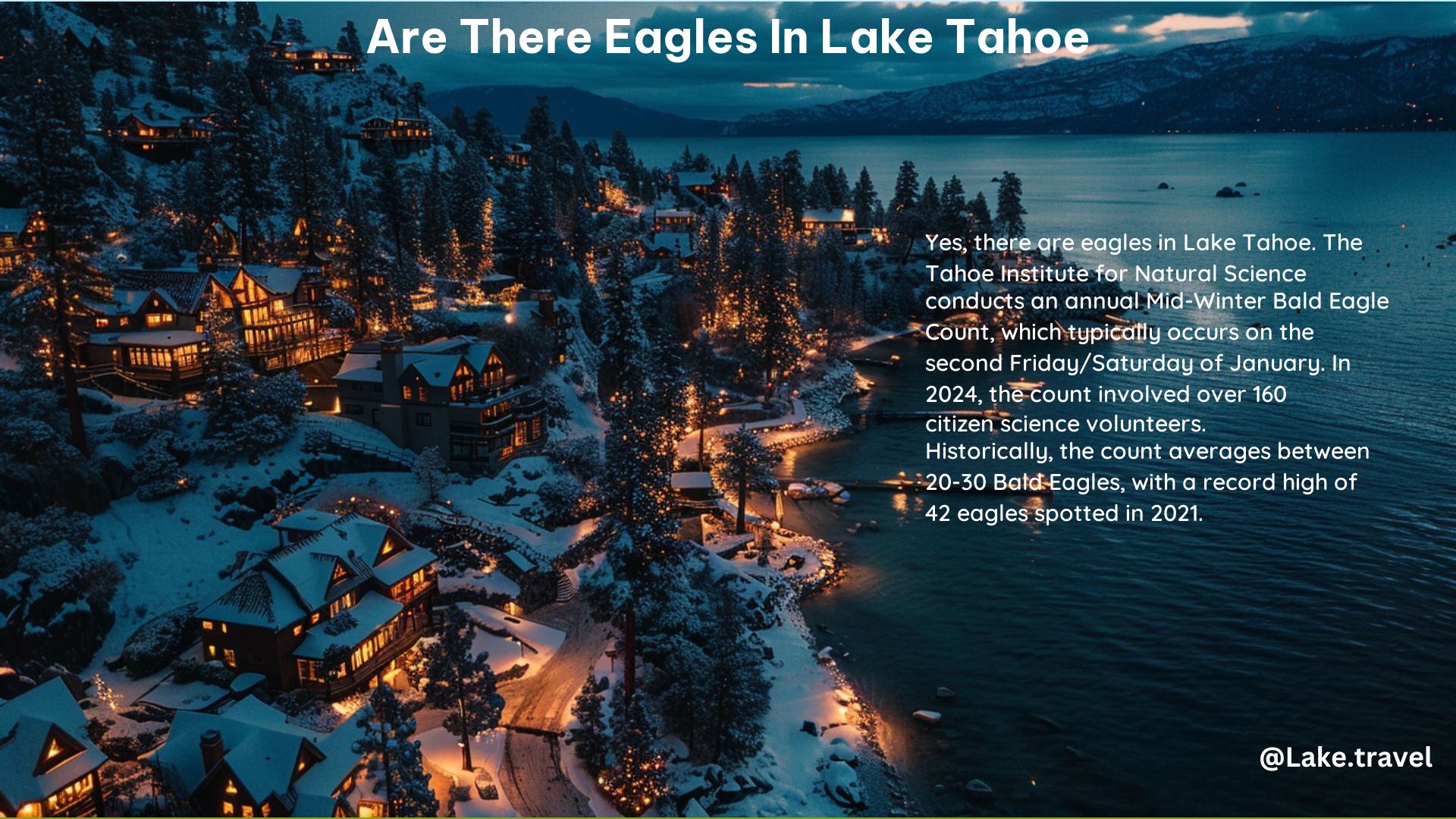Yes, there are eagles in Lake Tahoe. The region is home to a small but stable nesting bald eagle population. The Tahoe Institute for Natural Science conducts an annual Mid-Winter Bald Eagle Count, which has shown an increase in eagle numbers over the years. In 2021, a record 42 bald eagles were spotted during the count, while in 2023, 21 eagles were counted.
The Bald Eagle Population in Lake Tahoe
The bald eagle (Haliaeetus leucocephalus) is a majestic bird of prey that has become a symbol of the United States. These large raptors can be found throughout North America, and the Lake Tahoe region is one of the areas where they have established a stable breeding population.
According to the Tahoe Institute for Natural Science, the bald eagle population in the Lake Tahoe basin has been steadily increasing over the past few decades. The annual Mid-Winter Bald Eagle Count, which has been conducted since the 1980s, has recorded a growing number of eagles in the region.
In 2021, a record 42 bald eagles were spotted during the count, which is the highest number ever recorded in the Lake Tahoe basin. This is a significant increase from the early 2000s, when the count typically recorded around 20 to 30 eagles.
Where to Spot Bald Eagles in Lake Tahoe

Bald eagles can be spotted throughout the Lake Tahoe region, but there are a few key areas where they are more commonly observed:
-
Emerald Bay: This picturesque bay on the west shore of Lake Tahoe is a popular nesting site for bald eagles. The eagles can often be seen perched on the trees or soaring over the water.
-
Tahoe Keys: The Tahoe Keys, a man-made community on the south shore of Lake Tahoe, is another hotspot for bald eagle sightings. The eagles are attracted to the area’s abundant fish and waterfowl.
-
Spooner Lake: Spooner Lake, located on the east shore of Lake Tahoe, is a popular spot for birdwatchers and nature enthusiasts. Bald eagles have been known to frequent the area, particularly during the winter months.
-
Marlette Lake: This high-altitude lake, located just above the east shore of Lake Tahoe, is another area where bald eagles have been spotted. The eagles may use the lake as a hunting ground or a resting spot during their migrations.
The Importance of Bald Eagles in the Lake Tahoe Ecosystem
Bald eagles play a crucial role in the Lake Tahoe ecosystem. As apex predators, they help to maintain the balance of the food chain by preying on fish, waterfowl, and other small animals. Their presence is a testament to the overall health and biodiversity of the region.
Moreover, bald eagles are a protected species under the Bald and Golden Eagle Protection Act, which prohibits the hunting, killing, or disturbance of these birds. The presence of bald eagles in Lake Tahoe is a source of pride for the local community and a draw for ecotourism and wildlife enthusiasts.
Threats to Bald Eagles in Lake Tahoe
Despite the growing bald eagle population in Lake Tahoe, the birds still face a number of threats that could potentially impact their long-term survival in the region. Some of the key threats include:
-
Habitat Loss: The ongoing development and urbanization around Lake Tahoe can lead to the loss of suitable nesting and foraging habitats for bald eagles.
-
Disturbance: Increased human activity, such as recreational boating, hiking, and camping, can disturb the eagles and disrupt their breeding and feeding patterns.
-
Pollution: Contaminants in the lake, such as heavy metals and pesticides, can accumulate in the food chain and potentially harm the eagles.
-
Climate Change: The effects of climate change, such as changes in precipitation patterns and water levels, can impact the availability of the eagles’ prey and their overall habitat.
To address these threats, conservation efforts and public education campaigns are crucial to ensure the long-term survival of bald eagles in the Lake Tahoe region.
Bald Eagle Viewing Opportunities in Lake Tahoe
For those interested in seeing bald eagles in their natural habitat, there are several opportunities to do so in the Lake Tahoe region:
-
Mid-Winter Bald Eagle Count: The Tahoe Institute for Natural Science organizes an annual Mid-Winter Bald Eagle Count, which takes place in early January. This event is a great opportunity to join experienced birdwatchers and naturalists in spotting and counting the eagles.
-
Guided Tours: Several tour operators in the Lake Tahoe area offer guided bald eagle viewing tours, which can provide valuable insights into the birds’ behavior and habitat.
-
Self-Guided Exploration: Visitors can also explore the areas mentioned earlier, such as Emerald Bay, Tahoe Keys, and Spooner Lake, on their own to try and spot bald eagles in the wild.
Regardless of the approach, it’s important to remember to observe the eagles from a respectful distance and to follow all local regulations and guidelines to ensure the birds’ well-being.
Conclusion
The presence of bald eagles in the Lake Tahoe region is a testament to the area’s natural beauty and ecological diversity. These majestic birds of prey have found a home in the lake’s pristine waters and surrounding forests, and their numbers have been steadily increasing over the years.
While there are some threats to the bald eagle population, the local community and conservation efforts are working to protect these iconic birds and their habitat. By visiting Lake Tahoe and participating in bald eagle viewing opportunities, visitors can not only enjoy the stunning scenery but also contribute to the ongoing efforts to preserve this remarkable species.
References:
– Tahoe Institute for Natural Science – Bald Eagle Monitoring
– U.S. Fish and Wildlife Service – Bald Eagle
– Lake Tahoe Visitors Authority – Bald Eagles
